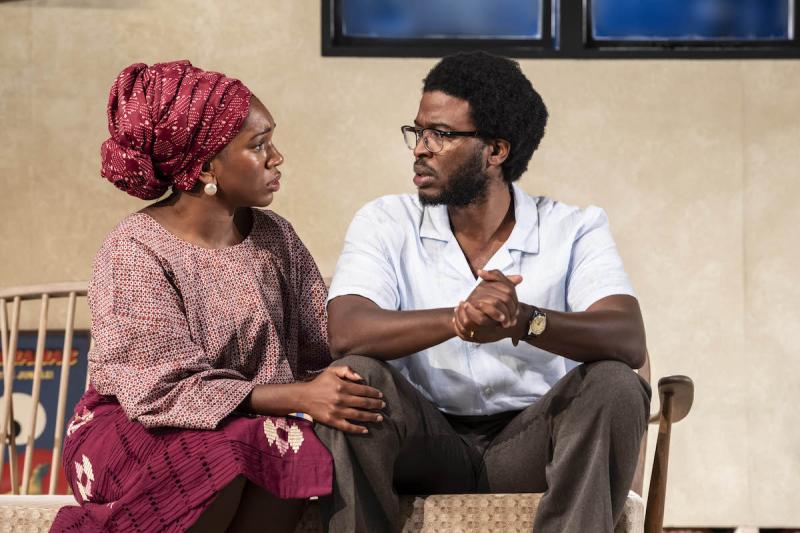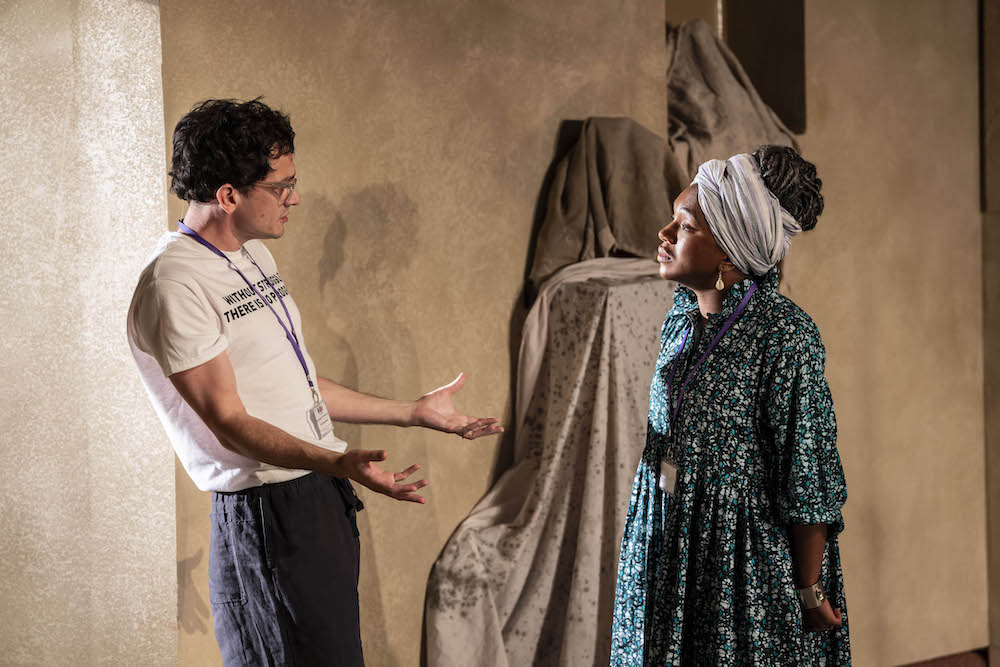Beneatha's Place, Young Vic review - strongly felt, but uneven | reviews, news & interviews
Beneatha's Place, Young Vic review - strongly felt, but uneven
Beneatha's Place, Young Vic review - strongly felt, but uneven
British premiere by this venue’s supremo is thrillingly provocative but also flawed

Trauma is the source of identity politics. In the case of African-Americans, the experience of brutal slavery, exploitative colonialism and violent racism are defining experiences in their history.
Although many recent black dramas have contested this with images of a more celebratory kind of identity, it remains a standard trope, as proved by Kwame Kwei-Armah’s 2013 play, Beneatha’s Place, which he directs himself at the Young Vic, where he is artistic director. In it he channels, among other things, his own experiences of living and working in the United States between 2011 and 2018.
An intertextual tribute to African-American culture, Kwei-Armah’s story is rooted in Lorraine Hansberry’s A Raisin in the Sun, which in 1959 was the first play by a Black woman to be staged on Broadway. In that drama, set in Chicago’s working-class South Side, Beneatha is Lena’s 20-year-old daughter whose dream is to be a medical student despite racial prejudice. When the family is ruined and lose all their money, Joseph Asagai, a Nigerian student, asks Beneatha to marry him and come with him when he returns to Africa. Although Hansberry leaves Beneatha’s choice uncertain, Kwei-Armah lends her a helping hand.
The first act of his story shows Beneatha and Asagai arriving in a white neighbourhood of Lagos in 1959 as the country fights for independence. Initially the tone is hilariously comic as Asagai, now a university professor and political activist, and his medical student wife are introduced to their new home by the ridiculously patronizing and openly racist Alabama missionaries Mr and Mrs Nelson. Just as living in the white neighbourhood of Clybourne Park was a dream for the black family in Hansberry’s play, here it becomes a re-run of the racial confrontations of Bruce Norris’s 2010 piece Clybourne Park.
As the Nelsons depart, comedy turns into something more serious. While Beneatha and Asagai begin to unpack their stuff, which includes his shocking collection of appallingly racist Jim Crow memorabilia, the political situation is sketched out. At one point, his Aunty Fola tells Beneatha that her husband is in a risky position because of tensions within the independence movement. The arrival of white American Daniel, probably a CIA agent, increases the tension. The problem with this flawed act is that the political situation is unclear and, despite some strong insights into American racism of the 1950s, the storytelling lacks impact because it’s hard to see exactly what’s at stake. The play’s second half is stronger and clearer. Although the first half is more about Asagai when really we want to know about his wife, it does provide the trauma that changes her life, and the second act shows her aged 70, a social anthropologist and Ivy League university dean (a chronology unnecessarily muddled by seemingly being set during the pandemic when she would be in her 80s and surely retired). What is thrilling is that Beneatha has returned to her old Lagos home from America, and assembled her academic colleagues – in Nigeria for a conference – to discuss the state of black studies at their institution.
The play’s second half is stronger and clearer. Although the first half is more about Asagai when really we want to know about his wife, it does provide the trauma that changes her life, and the second act shows her aged 70, a social anthropologist and Ivy League university dean (a chronology unnecessarily muddled by seemingly being set during the pandemic when she would be in her 80s and surely retired). What is thrilling is that Beneatha has returned to her old Lagos home from America, and assembled her academic colleagues – in Nigeria for a conference – to discuss the state of black studies at their institution.
This act is much more successful than the first in that there is some real fire in the debate, which is still contemporary, about whether these academics should continue African American studies or instead launch a Critical Whiteness course. Here the play catches fire with provocative comments not only by Beneatha, but also by her white colleagues, such as Mark and Harriet, who want change, and Gary and Wale, a black scion of a petro-rich family, who don’t. Their discussion is rich in ideas and aggressions, both micro and macro.
As they examine the notion of white privilege, the rights of white people to pontificate on race issues, and even to teach black studies, rather than critically examining their own social and cultural advantages, are all issues which are critically grappled with. The idea that black students are no longer interested in the trauma of previous generations and want a much more celebratory notion of race clashes with the experience of racism in both USA and UK. For white students, is guilt now a bore, and how can they support anti-racism without taking a white saviour role? Kwei-Armah offers no easy answers and the play ends quietly as Beneatha, left alone, contemplates her life’s achievements and its losses.
Designed by Debbie Duru, the playwright’s production of his work – which premiered in rep with Clybourne Park at Baltimore’s Center Stage, when he was artistic director there – is powerful, often comic, but also rather static. It’s an uneven play, but this revival features a dignified and commanding central performance by Cherrelle Skeete as Beneatha, who ages convincingly, and is well served by the rest of the cast which play two roles each: Zackary Momoh (Asagai/Wale), Sebastian Armesto (Daniel/Mark, pictured above with Skeete), Tom Godwin (Nelson/Gary) and Nia Gwynne (Mrs Nelson/Harriet). Jumoké Fashola gets some good laughs with her portrayal of Aunty Fola. At its best, the play is a panoramic satire which engages thought-provokingly with Hansberry and Norris.
rating
Explore topics
Share this article
more Theatre
 Two Strangers (Carry A Cake Across New York), Criterion Theatre review - rueful and funny musical gets West End upgrade
A Brit and a New Yorker struggle to find common ground in lively new British musical
Two Strangers (Carry A Cake Across New York), Criterion Theatre review - rueful and funny musical gets West End upgrade
A Brit and a New Yorker struggle to find common ground in lively new British musical
 Testmatch, Orange Tree Theatre review - Raj rage, old and new, flares in cricket dramedy
Winning performances cannot overcome a scattergun approach to a ragbag of issues
Testmatch, Orange Tree Theatre review - Raj rage, old and new, flares in cricket dramedy
Winning performances cannot overcome a scattergun approach to a ragbag of issues
 Banging Denmark, Finborough Theatre review - lively but confusing comedy of modern manners
Superb cast deliver Van Badham's anti-incel barbs and feminist wit with gusto
Banging Denmark, Finborough Theatre review - lively but confusing comedy of modern manners
Superb cast deliver Van Badham's anti-incel barbs and feminist wit with gusto
 London Tide, National Theatre review - haunting moody river blues
New play-with-songs version of Dickens’s 'Our Mutual Friend' is a panoramic Victori-noir
London Tide, National Theatre review - haunting moody river blues
New play-with-songs version of Dickens’s 'Our Mutual Friend' is a panoramic Victori-noir
 Machinal, The Old Vic review - note-perfect pity and terror
Sophie Treadwell's 1928 hard hitter gets full musical and choreographic treatment
Machinal, The Old Vic review - note-perfect pity and terror
Sophie Treadwell's 1928 hard hitter gets full musical and choreographic treatment
 An Actor Convalescing in Devon, Hampstead Theatre review - old school actor tells old school stories
Fact emerges skilfully repackaged as fiction in an affecting solo show by Richard Nelson
An Actor Convalescing in Devon, Hampstead Theatre review - old school actor tells old school stories
Fact emerges skilfully repackaged as fiction in an affecting solo show by Richard Nelson
 The Comeuppance, Almeida Theatre review - remembering high-school high jinks
Latest from American penman Branden Jacobs-Jenkins is less than the sum of its parts
The Comeuppance, Almeida Theatre review - remembering high-school high jinks
Latest from American penman Branden Jacobs-Jenkins is less than the sum of its parts
 Richard, My Richard, Theatre Royal Bury St Edmund's review - too much history, not enough drama
Philippa Gregory’s first play tries to exonerate Richard III, with mixed results
Richard, My Richard, Theatre Royal Bury St Edmund's review - too much history, not enough drama
Philippa Gregory’s first play tries to exonerate Richard III, with mixed results
 Player Kings, Noel Coward Theatre review - inventive showcase for a peerless theatrical knight
Ian McKellen's Falstaff thrives in Robert Icke's entertaining remix of the Henry IV plays
Player Kings, Noel Coward Theatre review - inventive showcase for a peerless theatrical knight
Ian McKellen's Falstaff thrives in Robert Icke's entertaining remix of the Henry IV plays
 Cassie and the Lights, Southwark Playhouse review - powerful, affecting, beautifully acted tale of three sisters in care
Heart-rending chronicle of difficult, damaged lives that refuses to provide glib answers
Cassie and the Lights, Southwark Playhouse review - powerful, affecting, beautifully acted tale of three sisters in care
Heart-rending chronicle of difficult, damaged lives that refuses to provide glib answers
 Gunter, Royal Court review - jolly tale of witchcraft and misogyny
A five-women team spell out a feminist message with humour and strong singing
Gunter, Royal Court review - jolly tale of witchcraft and misogyny
A five-women team spell out a feminist message with humour and strong singing
 First Person: actor Paul Jesson on survival, strength, and the healing potential of art
Olivier Award-winner explains how Richard Nelson came to write a solo play for him
First Person: actor Paul Jesson on survival, strength, and the healing potential of art
Olivier Award-winner explains how Richard Nelson came to write a solo play for him

Add comment